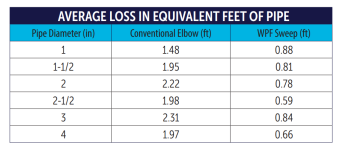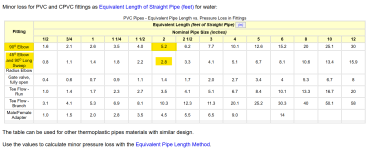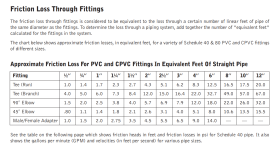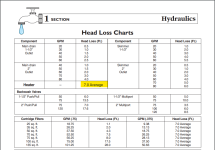I did some research on Chatgtp, and here is what it said.
ChatGTP learns from the internet and unfortunately, the internet has some wrong information.
The efficiency difference between a PVC 90-degree sweep elbow and a PVC 90-degree street elbow is primarily based on hydraulic resistance, or how much each fitting restricts flow and increases pressure loss in your pool system.
This part is true.
Here's a comparison based on
equivalent length — a standard method in fluid dynamics that expresses the resistance of a fitting as an equivalent length of straight pipe:
🛠 Equivalent Length Comparison (2-inch Schedule 40 PVC):
| Fitting Type | Equivalent Length | Relative Efficiency |
|---|
| 90° Sweep Elbow | ~6–8 feet | High efficiency |
| 90° Standard Elbow | ~8–10 feet | Medium efficiency |
| 90° Street Elbow | ~10–12 feet | Lowest efficiency |
These equivalent lengths are not reflective of most internet sources regarding head loss of fittings so I am not sure where they got the info for this but I have never seen values that high for those fittings.
Head loss is dependent on geometry and manufactures tend to have unique geometry so it really depends on the exact fitting used.
A while back I did some simulations on fittings that manufactures had CAD drawings on so that I could accurately model the fitting as best as possible:
Lasco 90 - 6' Equivalent Length
Nibco 90 - 5' Equivalent Length
Sweep 90 1" Curve - 3' Equivalent Length (note that larger radii will have less head loss)
 Key Points:
Key Points:
- A sweep elbow has a larger radius, which reduces turbulence and friction loss.
True
- A street elbow has a short radius and male-female connection, often causing more abrupt turns and greater head loss.
A sweep as well as any fitting has a male-female connection. It is the short radius which causes the higher head loss.
- Replacing a 90° street elbow with a sweep elbow can reduce resistance by up to 30–40% for that individual fitting, which can be significant when scaling across multiple elbows in your system.
Rarely true for pool plumbing. Most of the head loss in a typical pool plumbing tends to be in other places than elbows (e.g. filter, heater, valves, etc). I did a model of my own plumbing to see what the effect of replacing the ELL 90s on the pad with sweeps, 7-90s total:
Full Speed Results:
2" Ell 90s Operating Point: 31.15' Head, 65.74 GPM, 983 Watts
2" Sweep 90s Operating Point: 30.70' Head, 66.32 GPM, 985 Watts
40% Speed Results (normal speed):
2" Ell 90s Operating Point: 4.98' Head, 26.30 GPM, 85.97 Watts
2" Sweep 90s Operating Point: 4.91' Head, 26.53 GPM, 86.13 Watts
So not much different and not really worth the effort.
Plus many systems like mine only allow 5% increments in pump speed so you may not achieve any energy savings by going with sweeps unless you can improve the flow rate by at least 5% and lower the RPM by 5%.






















